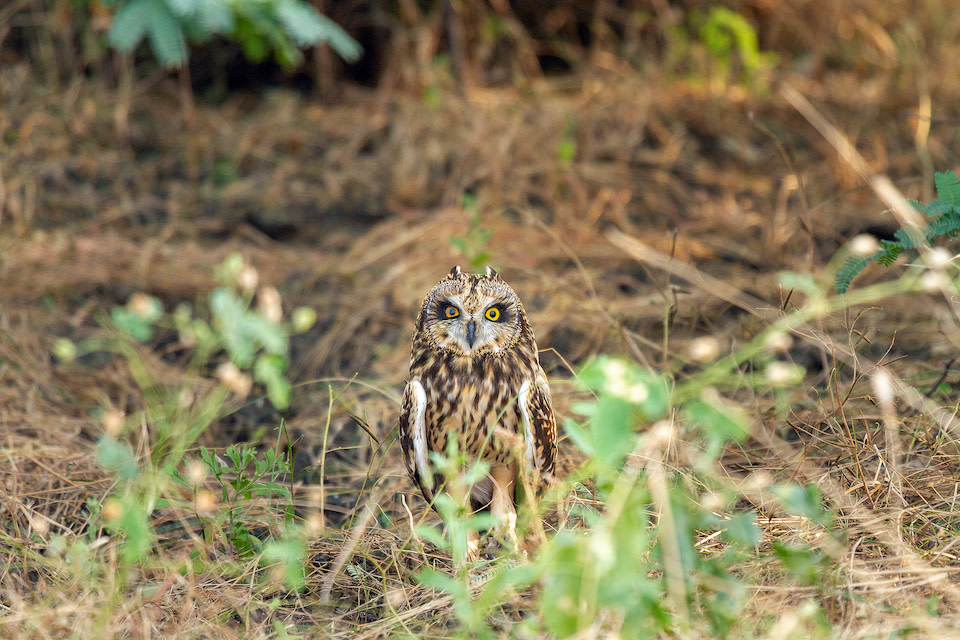 Listen to this article
•
15:34 min
Listen to this article
•
15:34 min
Whoever decided that the collective noun for a group of owls should be “parliament” must have had an experience similar to the one Aiubbhai and I shared one brisk winter’s evening in the Little Rann of Kachchh. Aiubbhai was the driver-cum-naturalist from Rann Riders, a leading wildlife lodge in the area, who was taking me out on a safari. The Little Rann is a unique ecosystem that is often confused with the Rann of Kachchh, a few hours drive to the west.
Aiubbhai and I left the lodge at around 2 pm, determined to get in a few hours of tracking the birds and animals of the Little Rann before the winter’s fading light brought the day to an early close. As we entered the Little Rann, Aiubbhai asked if I wanted to try and spot some owls. For three days before that, I’d been tracking a lone, and very elusive, Indian eagle owl in another part of the area and my appetite for sighting an owl had been whetted. I hadn’t even finished saying “Of course!” when Aiubbhai swung the jeep around and drove us towards Meldi no Dhoro, a bet (island) in the Little Rann named after Meldi Mata, a prominent local goddess. Bets are the name given to these areas because they are elevated patches of land that stay dry even when the rains flood the land around them. They have a prolific growth of acacia and other trees and bushes, and are a monsoon refuge for humans and animals alike.

Short-eared owls live in open landscapes such as marshes arid grasslands, and unlike their elusive cousins are relatively easy to spot. This owl was seen in the Little Rann of Kachchh. Cover Photo: Arindam Bhattacharya
On the 15-minute drive I got to know my companion better. I discovered his full name is Vhepari Aiubbhai Mirajibhai and that he hails from a family of horse traders, which is why Vhepari (Gujarati for trader or businessman) is part of his name. Watching his absolute control of the jeep, through the marshy, boggy bits of the Rann made me wonder if his ancestors had displayed the same kind of mastery over their steeds.
Without warning, we turned off the salt flats and into the thick copse of acacia bushes that is Meldi no Dhoro. Aiubbhai scanned the vegetation around us as he tried to pick a way between the dense thorns. Suddenly, the bush to our left exploded in a flurry of wings as a short-eared owl (Asio flammeus) flew off the ground and disappeared into the trees. We reached a clearing and were slowing down to a crawl when Aiubbhai caught my eye and pointed to another tree 20 feet ahead of us. There, at its base, sat another short-eared owl, regarding us with a curious, but unworried gaze. As I shifted in my seat to get a better angle for my photograph, the owl shifted on one foot and raised the short tufts of feathers atop its head.

The short-eared owl is a unique member of its species for two reasons — it is a ground roosting bird and it is active during the day, especially at dawn and dusk. This species is spread widely across most of the globe and is quite common across Asia. It favours grasslands and open countryside and tends to migrate to warmers places in the winter, making the Little Rann of Kachchh one of its favoured winter habitats in this part of the world. The Rann’s open marshland and robust rodent populations, turn this landscape into a larder for the birds.
The short-eared owl is named for the barely visible tufts of feathers atop its head, which it raises when alarmed or defensive. The untrained eye can easily mistake it for the long-eared owl. Aside from the obvious difference in tuft length that their names make clear, the long-eared owl prefers dense woodlands as opposed to the favoured open grasslands of the short-eared owl and its irises tend to be orange in colour, while the short-eared owl’s are a striking yellow.

The short-eared owl is called ravaido in Gujarati, and contrary to the solitary nature of most other owl species, it favours communal roosting. This unusual aspect to its social behaviour was the reason that we were able to witness a parliament of them and why I was able to understand why it is a perfect collective noun that describes these creatures. Over 30 minutes, Aiubbhai and I drove this way and that through the thorny scrub, spying owls that would regard us with curiosity from a distance until we attempted to get a wee bit closer. Then, they’d fly away quicker, and smoother, than a politician who’s spotted a flock of reporters, cameras, and microphones. Now if only our elected parliamentarians had even half this tact and grace.






